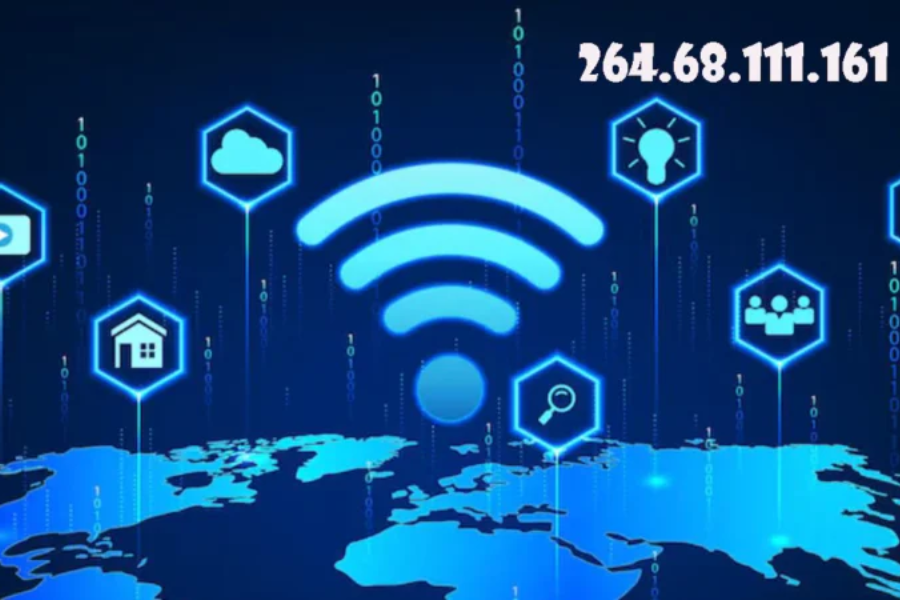The IP address 264.68.111.161 has stirred confusion and curiosity across tech communities and cybersecurity circles. It doesn’t belong to any valid IPv4 or IPv6 range, yet it appears in network logs, system alerts, and traffic reports. This has led many to question whether it’s a real device address, a bug, or part of something more sinister.
Could this phantom IP be a harmless glitch, or is it a tool used by cybercriminals to mask their tracks? As more users encounter it during everyday internet connectivity checks or router configuration reviews, the mystery only deepens. Understanding its origins is crucial for both IT professionals and everyday users concerned about online safety.
What is 264.68.111.161 and Why Does It Matter?
An IP address is a unique identifier that helps devices talk to each other over the internet. Every phone, laptop, and smart device needs one. 264.68.111.161, however, doesn’t fit the mold. Standard IPv4 addresses only range from 0.0.0.0 to 255.255.255.255. So 264.68.111.161 breaks that limit. In short, it shouldn’t be valid.
Yet, this address keeps appearing in logs and reports. Why? Some experts believe it’s a sign of malware protection software misreading data. Others think it’s a deliberate part of device communication tricks used to confuse systems. Either way, it shows how something as simple as a number can raise huge questions about connectivity issues and network stability.
Understanding IP Address Assignment and Classification
All real IP addresses come from IANA, the Internet Assigned Numbers Authority. They give out blocks of IPs to ISPs and big companies. These addresses fall into types: static IP, dynamic IP, private, and public. Static IPs stay the same, good for remote access or hosting. Dynamic IPs change often, which helps with internet connectivity.
There’s also a list of addresses set aside for special uses. These include content restrictions, testing, and private networks. But 264.68.111.161 is not part of any known class. It’s not even listed in the reserved or private ranges. This makes it even more mysterious and points to a possible IP conflict, fake entry, or worse—security vulnerabilities.
Is 264.68.111.161 a Real IP or a Fabricated One?
Technically, 264.68.111.161 is fabricated. Since the first number, 264, is out of range for IPv4, most network tools mark it as invalid. But if it’s fake, how is it ending up in firewall logs, system alerts, or traffic captures? Some believe it’s inserted by faulty code, outdated router firmware, or rogue tools pretending to send traffic from a phantom source.
Another theory suggests it’s a trick used by masked IP technologies or proxy servers. Hackers might insert fake addresses like this to break user behavior tracking tools or to confuse geographic targeting systems. The idea is to hide the real device address and mess with standard detection methods.
Cybersecurity Concerns Linked to Phantom IPs
When addresses like 264.68.111.161 show up, they often lead to serious online threat prevention concerns. They can bypass simple filters or create access restriction issues. Even advanced firewall protection systems can be fooled if they aren’t set up to block invalid addresses. This allows hackers to test the defenses of a network without revealing their real IP.
Another big problem is the false sense of security. If you’re not trained in cybersecurity best practices, you might ignore these signs. But letting one strange entry slide could open the door to data exposure, hidden malware, or backdoor access. It’s important for users and businesses alike to stay alert and monitor their network settings closely.
The Role of IPs in Digital Surveillance and Tracking
IPs are central to location tracking and anonymous browsing. Governments and companies use them to watch what you do online. If a phantom IP like 264.68.111.161 appears, it can create confusion in user behavior tracking systems. Is it real? Is it fake? These questions delay investigations and may let bad actors go undetected.
Even worse, some researchers suggest fake IPs may be used by surveillance programs to plant false clues or shift blame. It’s not far-fetched to think a suspicious link in your inbox might point to or come from such an address. That’s why checking the digital footprint of unknown IPs is vital to keeping your personal data privacy safe.
How Hackers Use IP Anomalies for Obfuscation
Cybercriminals often use fake or weird IPs to cover their tracks. They bounce their traffic through Virtual Private Networks (VPNs), proxy servers, or even custom-built relays that mix real and fake traffic. A masked IP like 264.68.111.161 can throw off tracking tools, making it harder to find the origin of an attack.
This tactic is especially dangerous in public Wi-Fi security scenarios. When hackers use an invalid IP, it may bypass certain filters set by routers or Wi-Fi systems. That’s why keeping your router configuration updated, using encrypted connections, and maintaining firmware updates is key to avoiding these hidden threats.
Where Has 264.68.111.161 Been Detected?
Reports of 264.68.111.161 appearing come from IT forums, security blogs, and server hosting logs. Some users spotted it during unusual internet connectivity issues. Others saw it listed as a source of strange incoming traffic. Most tools flagged it as invalid, but that didn’t stop it from showing up.
Here’s a table of where and how it’s been seen:
| Source Type | Description | Risk Level |
| Network Traffic Logs | Fake source address during scans | High |
| Firewall Alerts | Denied access attempts | Medium |
| Router Logs | Detected as malformed traffic | High |
| SIEM Tools | Triggered anomalies | Medium |
These reports suggest a pattern: 264.68.111.161 may be used to test or confuse systems rather than act as a real connection point.
Psychology and Pop Culture of Phantom IPs
Phantom IPs like this have become part of internet lore. Some people believe they’re signs of hidden programs, ghost networks, or even digital espionage. These ideas have popped up in hacker forums, Reddit threads, and tech fiction. They play into the fear of the unknown—something that looks technical but might hide danger.
Stories of ghost addresses that trace back to nowhere aren’t new. They stir emotions of paranoia and fascination. Just like in haunted house tales, the presence of 264.68.111.161 on your screen feels eerie. It’s not just a number; it’s a symbol of how little we know about the deep layers of the web.
How to Protect Yourself from Suspicious IP Activity
If you want to stay safe, always monitor your logs and alerts. If you spot an IP that looks like 264.68.111.161, don’t ignore it. Make sure your firewall rules are up-to-date and use tools that allow anonymous browsing only through safe VPN services. Avoid clicking suspicious links, especially on public Wi-Fi.
Also, keep your router firmware current. Old software often has bugs that let fake addresses sneak through. Set your router to log all connections and scan for anomalies. Use malware protection tools that check for weird IP activity. This will help shield your digital identity from hackers trying to slip in under the radar.
Final Thoughts: Is 264.68.111.161 a Threat or Just a Legend?
So, what is 264.68.111.161 really? A harmless glitch? A hacker’s decoy? Or something far more complicated? It may never be linked to a major attack, but its presence still raises flags. It reminds us how fragile internet protocol structures can be and why we must stay alert.
In the end, whether 264.68.111.161 is a true threat or just tech folklore, its story teaches us to take every device address seriously. The next time you check your logs, you might spot something strange. And when you do, you’ll know not to dismiss it. Because in the world of cybersecurity, even ghosts can leave real scars.
Explore in-depth analysis and expert opinions only at ExecuteBuzz.com.


